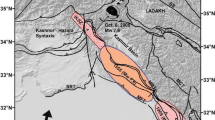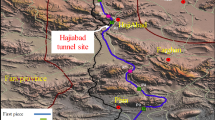Abstract
Tunnels allow the continuity of rural road and urban transportation networks. Their shutdown provokes a loss in the transport system’s level service, which entails higher road user costs. Earthquakes are the hazard that most affect the tunnels’ serviceability. Depending on the structural damage’s magnitude, the serviceability loss can be at different degrees, from marginal changes in traffic flow, associated with minor damages, to traffic interruption, associated with collapsing. Because of seismic phenomena’ randomness nature, its effect on tunnel serviceability is estimated in probabilistic terms. Traffic interruption probability was estimated using fragility curves, representing the probability of achieving a specific damage state regarding the seismic hazard intensity. The calibration of tunnel fragility curves requires large samples of damages, seismic intensities, and geological and constructive data, which are not always available, especially in countries with a small number of tunnels in their road network. This work proposes a simplified procedure for evaluating the tunnels’ traffic interruption probability due to earthquakes. The approach proposed uses existent seismic exposures maps, a strategy for selecting from existing fragility curves the more suitable, and a simple method to estimate the traffic interruption probability. The procedure analysed 20 tunnels affected by the Maule earthquake in Chile. These tunnels experimented PGA between 0.12 and 0.36 g. The highest risk values were obtained in tunnels without alternative routes and high repairing costs.
Similar content being viewed by others
References
Akiyama M, Frangopol D, Ishibashi H (2020) Toward lifecycle reliability-, risk- and resilience-based design and assessment of bridges and bridge networks under independent and interacting hazards: emphasis on earthquake, tsunami and corrosion. Struct Infrastruct Eng 16(1–2):26–50. https://doi.org/10.1080/15732479.2019.1604770
ALA (2001) Seismic fragility formulations for water systems, part 1 Guideline, American Lifelines Alliance, United States
Andreotti G (2019) Lai CG (2019) Use of fragility curves to assess the seismic vulnerability in the risk analysis of mountain tunnels. Tunn Undergr Space Technol. https://doi.org/10.1016/j.tust.2019.103008
Andreotti G, Lai CG (2015) Methodology to derive damage state-dependent fragility curves of underground tunnels. In: 6th International conference on earthquake geotechnical engineering, 1–4 November, Christchurch, New Zealand
Argyroudis S, Pitilakis KD (2012) Seismic fragility curves of shallow tunnels in alluvial deposits. Soil Dyn Earthq Eng 35:1–12. https://doi.org/10.1016/j.soildyn.2011.11.004
Argyroudis S, Kaynia AM (2014) Fragility functions of highway and railway infrastructure. In: Pitilakis K et al (eds) SYNER-G: typology definition and fragility functions for physical elements at seismic risk, geotechnical, geological and earthquake engineering 27. Springer, Dordrecht, pp 299–326
Argyroudis S, Tsinidis G, Gatti F, Pitilakis KD (2014) Seismic fragility curves of shallow tunnels considering SSI and aging effects. In: 2nd Eastern European tunneling conference, 28 Sep–1 Oct, Athens, Greece
Argyroudis S, Tsinidis G, Gatti F, Pitilakis KD (2017) Effects of SSI and lining corrosion on the seismic vulnerability of shallow circular tunnels. Soil Dyn Earthq Eng 98:244–256. https://doi.org/10.1016/j.soildyn.2017.04.016
Argyroudis S, Mitoulis SA, Winter M, Kaynia AM (2019) Fragility of transport assets exposed to multiple hazards: state-of-the-art review toward infrastructural resilience. Reliab Eng Syst Saf. https://doi.org/10.1016/j.ress.2019.106567
Argyroudis S, Mitoulis SA, Hofer LZ (2020) Resilience assessment framework for critical infrastructure in a multi-hazard environment: case study on transport assets. Sci Total Environ 714(2020):1–20. https://doi.org/10.1016/j.scitotenv.2020.136854
Asakura T, Tsukada K, Matsunaga T, Matsuoka S, Yashiro K, Shiba Y, Oya T (2007) Damage to mountains tunnels by earthquake and its mechanism. In: 11th International society for rock mechanics and rock engineering congress, 9–13 July, Portugal
Avanaki MH, Hoseini A, Vahdani S, de Santos C (2018) Seismic fragility curves for vulnerability assessment of steel fiber reinforced concrete segmental tunnel linings. Tunn Undergr Space Technol 78(2018):259–274. https://doi.org/10.1016/j.tust.2018.04.032
Chen CH, Wang TT, Jeng FS, Huang TH (2012) Mechanisms causing seismic damage of tunnels at different depths. Tunn Undergr Space Technol 28:31–40
Choun YS, Elnashai AS (2010) A simplified framework for probabilistic earthquake loss estimation. Probab Eng Mech 25(4):355–364. https://doi.org/10.1016/j.probengmech.2010.04.001
Codermatz R, Nicolich R, NSlejko D (2003) Seismic risk assessments and GIS technology: applications to infrastructures in the Friuli-Venezia Giulia region (NE Italy). Earthq Eng Struct Dyn 32:1677–1690. https://doi.org/10.1002/eqe.294
Corigliano M, Lai CG, Barla G (2007) Seismic vulnerability of rock tunnels using fragility curves. In: Ribeiro e Sousa L, Olalla C, Grossmann N (eds) 11th Congress of the international society for rock mechanics, Taylor and Francis, London, pp 1173–1176
D’Andrea A, Cafiso S, Condorelli A (2005) Methodological considerations for the evaluation of seismic risk on road network. Pure Appl Geophys 162(2005):767–782. https://doi.org/10.1007/s00024-004-2640-0
De Silva F, Fabozzi S, Nikitas N, Bilotta E, Fuentes R (2020) Seismic vulnerability of circular tunnels in sand. Géotechnique. https://doi.org/10.1680/jgeot.19.SiP.024
Decò A, Bochini P, Frangopol D (2013) A probabilistic approach for the prediction of seismic resilience of bridges. Earthq Eng Struct Dyn 42:1469–1487. https://doi.org/10.1002/eqe.2282
Dowding CH, Rozen A (1978) Damage to rock tunnels from earthquake shaking. J Geotech Eng Div 104(2):175–191
Elnashai A, Gencturk B, Kwon OS, Al-Qadi I, Hashash Y, Roesler J, Kim SJ, Jeong, SH, Dukes J, Valdivia A (2010) The Maule (Chile) earthquake of February 27, 2010. Consequence assessment and case studies. Mid-America Earthquake Center. Report No. 10-04. MAE Center, United States
Fabozzi S, Bilotta EP, Zollo M (2018) Feasibility study of a loss-driven earthquake early warning and rapid response systems for tunnels of the Italian high-speed railway network. Soil Dyn Earthq Eng 112(2018):232–242. https://doi.org/10.1016/j.soildyn.2018.05.019
FEMA (2011) Multi-hazard loss estimation methodology. Earthquake model. Technical manual. Federal Emergency Management Agency, United States
Hu X, Zhou Z, Chen H, Ren Y (2020) Seismic fragility analysis of tunnels with different buried depths in a soft soil. Sustainability 12:892. https://doi.org/10.3390/su12030892
Huang G, Qiu W, Zhang J (2017) Modelling seismic fragility of a rock mountain tunnel based on support vector machine. Soil Dyn Earthq Eng 102(2017):160–171. https://doi.org/10.1016/j.soildyn.2017.09.002
Huang ZK, Pitilakis K, Tsinidis G, Argyroudis S, Zhang DM (2020) Seismic vulnerability of circular tunnels in soft soil deposits: the case of Shanghai metropolitan system. Tunn Undergr Space Technol. https://doi.org/10.1016/j.tust.2020.103341
Kennedy RP, Cornell CA, Campbell RD, Kaplan S, Perla HF (1980) Probabilistic seismic safety study of an existing nuclear power plant. Nucl Eng Des 59(2):315–338. https://doi.org/10.1016/0029-5493(80)90203-4
Le TS, Huh J, Park JH (2014) Earthquake fragility assessment of the underground tunnel using an efficient SSI analysis approach. J Appl Math Phys 2:1073–1078. https://doi.org/10.4236/jamp.2014.212123
Medina F, Yanev PI, Yanev A (2010) El terremoto de magnitud 8,8 costa afuera de la región del Maule, Chile del 27 de febrero de 2010. Resumen preliminar de los daños y recomendaciones de ingeniería. Reporte 70138. Banco Mundial, Estados Unidos (in Spanish)
MOP (2016) Asset valuation of the national highway network. Highways Management Department (in Spanish). Ministry of Public Works. Chile
MOP (2018) National Traffic Survey Ministry of Public Works, Chile
MOP (2019) Quarterly reports (in Spanish). Public Works Concessions Directorate. Ministry of Public Works, Chile
MSDF (2020) Unit cost of the national investment system. Ministry of Social Development and Family, Chile (in Spanish)
Nazari YR, Bargi K (2012) Practical approach to fragility analysis of bridges. Res J Appl Sci Eng Technol 4(23):5177–5182
Nguyen DD, Park D, Shamsher S, Nguyen VQ, Lee TH (2019) Seismic vulnerability assessment of rectangular cut-and-cover subway tunnels. Tunn Undergr Space Technol 86:247–261. https://doi.org/10.1016/j.tust.2019.01.021
Osmi SKC, Ahmad SM (2016) Seismic fragility curves for shallow circular tunnels under different soil conditions. J Civ Environ Eng 10(10):1351–1357
Park D, Lee TH, Nguyen DD, Ahn JK (2019) Development of fragility curves for underground box tunnels from nonlinear frame analysis. In: Silvestri F, Moraci N (eds) Earthquake geotechnical engineering for protection and development of environment and constructions—proceedings of the 7th international conference on earthquake geotechnical engineering, pp 4371–4378
Poulos A, Monsalve M, Zamora N, de la Llera JC (2019) An updated recurrence model for Chilean subduction seismicity and statistical validation of its Poisson nature. Bull Seismol Soc Am 109(1):66–74. https://doi.org/10.1785/0120170160
Qiu W, Huang G, Zhou H, Xu W (2018) Seismic vulnerability analysis of rock tunnel. Int J Geomech. https://doi.org/10.1061/(ASCE)GM.1943-5622.0001080
Rossetto T, D’Ayala D, Ioannou I, Meslem A (2014) Evaluation of existing fragility curves. In: Pitilakis K et al (eds) SYNER-G: typology definition and fragility functions for physical elements at seismic risk, geotechnical, geological and earthquake engineering 27. Springer, Dordrecht, pp 47–93
Roy N, Sarkar R (2017) A review of seismic damage of mountains tunnels and probable failure mechanisms. Geotech Geol Eng 35(2017):1–28. https://doi.org/10.1007/s10706-016-0091-x
Scherbaum F, Kuehn N (2011) Logic tree branch weights and probabilities: summing up to one is not enough. Earthq Spectra 27(4):1237–1251. https://doi.org/10.1193/1.3652744
Scherbaum F, Bommer J, Bungum H, Cotton F, Abrahamson NA (2005) Composite ground-motion models and logic trees: methodology, sensitivities, and uncertainties. Bull Seismol Soc Am 95(5):1575–1593. https://doi.org/10.1785/0120040229
Selva J, Argyroudis S, Pitilakis K (2013) Impact on loss/risk assessments of inter-model variability in vulnerability analysis. Nat Hazards 67(2):723–746. https://doi.org/10.1007/s11069-013-0616-z
Sharma S, Judd W (1991) Underground opening damage from earthquakes. Eng Geol 30:263–276. https://doi.org/10.1016/0013-7952(91)90063-Q
Shedlock KM, Tanner JG (1999) Seismic hazard map of the western hemisphere. Ann Geophys 42(6):1199–1214. https://doi.org/10.4401/ag-3779
Shinozuka M, Feng MQ, Lee J, Naganuma T (2000) Statistical analysis of fragility curves. J Eng Mech 126(12):1224–1231. https://doi.org/10.1061/(ASCE)0733-9399(2000)126:12(1224)
Vanuvamalai A, Jaya KP, Balachandran V (2018) Seismic performance of tunnels structures: a case study. Nat Hazards 93(1):453–468. https://doi.org/10.1007/s11069-018-3308-x
Wang ZZ, Zhang Z (2013) Seismic damage classification and risk assessment of mountain tunnels with a validation for the 2008 Wenchuan earthquake. Soil Dyn Earthq Eng 45(2013):45–55. https://doi.org/10.1016/j.soildyn.2012.11.002
Wang WL, Wang TT, Su JJ, Lin CH, Seng CR, Huang TH (2001) Assessment of damage in mountains tunnels due to the Taiwan Chi-Chi earthquake. Tunn Undergr Space Technol 16(1):133–150. https://doi.org/10.1016/S0886-7798(01)00047-5
Werner S, Taylor C, Cho S, Lavoie JP, Huyck C, Eitzel C, Chung H, Eguchi R (2006) Redars 2 methodology and software for seismic risk analysis of highway systems. Special report MCEER-07-SP08, The State University of New York, United States
Xiaoquing F, Junqui L, Xiaolan Z, Runzhou L (2008) Damage evaluation of tunnels in earthquakes. In: 14th World conference on earthquake engineering, October 12–17, Beijing. China
Yen WH, Chen G, Buckle I, Allen T, Alzamora D, Ger J, Arias JG (2011) Post-earthquake reconnaissance report on transportation infrastructure: impact of the February 27, 2010, Offshore Maule Earthquake in Chile. Report FHWA-HRT-11-030. Federal Highway Administration. The United States
Zhang X, Jiang Y, Sugimoto S (2018) Seismic damage assessment of mountain tunnel: a case study on the Tawarayama tunnel due to the 2016 Kumamoto earthquake. Tunn Undergr Space Technol 71(2018):138–148. https://doi.org/10.1016/j.tust.2017.07.019
Acknowledgements
The authors thank the National Research and Development Agency (ANID) of Chile for supporting the projects CONICYT/FONDAP/15110017 project “National Research Center for Integrated Natural Disaster Management (CIGIDEN)” and FONDECYT 1181754 “Socio-economic modelling of mitigation strategies for resilient critical infrastructure: application to drink water systems and road networks”, within which this paper was prepared.
Author information
Authors and Affiliations
Corresponding author
Additional information
Publisher's Note
Springer Nature remains neutral with regard to jurisdictional claims in published maps and institutional affiliations.
Rights and permissions
About this article
Cite this article
Cartes, P., Chamorro, A. & Echaveguren, T. Seismic risk evaluation of highway tunnel groups. Nat Hazards 108, 2101–2121 (2021). https://doi.org/10.1007/s11069-021-04770-1
Received:
Accepted:
Published:
Issue Date:
DOI: https://doi.org/10.1007/s11069-021-04770-1










